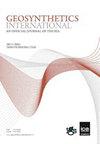高渗滤液水头城市生活垃圾填埋场内衬系统的突破时间评估
IF 3.3
2区 工程技术
Q2 ENGINEERING, GEOLOGICAL
引用次数: 0
摘要
本文提出了一种基于指示性污染物(氯化物)突破时间的高渗滤液城市生活垃圾填埋场内衬系统设计方法。对不同厚度的粘土压实衬垫和衰减层的衬垫系统进行了性能评价。土工膜和0.75厚度的压实粘土衬砌组成的单一复合衬砌可以满足衰减层厚度> 3m、平均废土高度HD < 60 m的情况下衬砌系统50年突破时间的要求。中国垃圾填埋场标准中提出的由两个土工膜和一个0.3m厚度的压实粘土衬垫组成的双层衬垫系统,无法满足衬垫系统50年突破时间的要求,特别是对于大型垃圾填埋场(如HD > 60 m),对于平均高度超过60 m的垃圾填埋场,可以使用由一个土工膜和一个0.3m厚度的压实粘土衬垫组成的两个复合衬垫的双层复合衬垫。针对不同设计垃圾平均高度和衰减层厚度的其他情况,提出了不同的衬里系统。它们可以很容易地用于高渗滤液头的都市固体废物堆填区。本文章由计算机程序翻译,如有差异,请以英文原文为准。
Breakthrough time assessment of liner system for MSW landfills with high leachate heads
This paper presents a design method for liner systems of municipal solid waste (MSW) landfills with high leachate heads based on the breakthrough time of an indicative contaminant (Chloride). The performance of liner systems with varying thicknesses of compacted clay liner and attenuation layer was assessed. The single composite liner consisting of a geomembrane and a 0.75-thickness compacted clay liner can meet the 50-year breakthrough time requirement of the liner system for cases with the thickness of the attenuation layer > 3m and the average height of waste HD < 60 m. The double liner system consisting of two geomembranes with one single 0.3m-thickness compacted clay liner, as proposed in the Chinese landfill standards, cannot meet the 50-year breakthrough time requirement of the liner system, especially for large-scale landfills (e.g., HD > 60 m). The double composite liner with two composite liners consisting of a geomembrane and a 0.3m-thickness compacted clay liner can be used for a landfill with an average height of over 60 m. Different liner systems for other cases with different average design heights of waste and the thickness of the attenuation layer were proposed. They can be easily used for MSW landfills with high leachate heads.
求助全文
通过发布文献求助,成功后即可免费获取论文全文。
去求助
来源期刊

Geosynthetics International
ENGINEERING, GEOLOGICAL-GEOSCIENCES, MULTIDISCIPLINARY
CiteScore
6.90
自引率
20.00%
发文量
91
审稿时长
>12 weeks
期刊介绍:
An online only, rapid publication journal, Geosynthetics International – an official journal of the International Geosynthetics Society (IGS) – publishes the best information on current geosynthetics technology in research, design innovation, new materials and construction practice.
Topics covered
The whole of geosynthetic materials (including natural fibre products) such as research, behaviour, performance analysis, testing, design, construction methods, case histories and field experience. Geosynthetics International is received by all members of the IGS as part of their membership, and is published in e-only format six times a year.
 求助内容:
求助内容: 应助结果提醒方式:
应助结果提醒方式:


